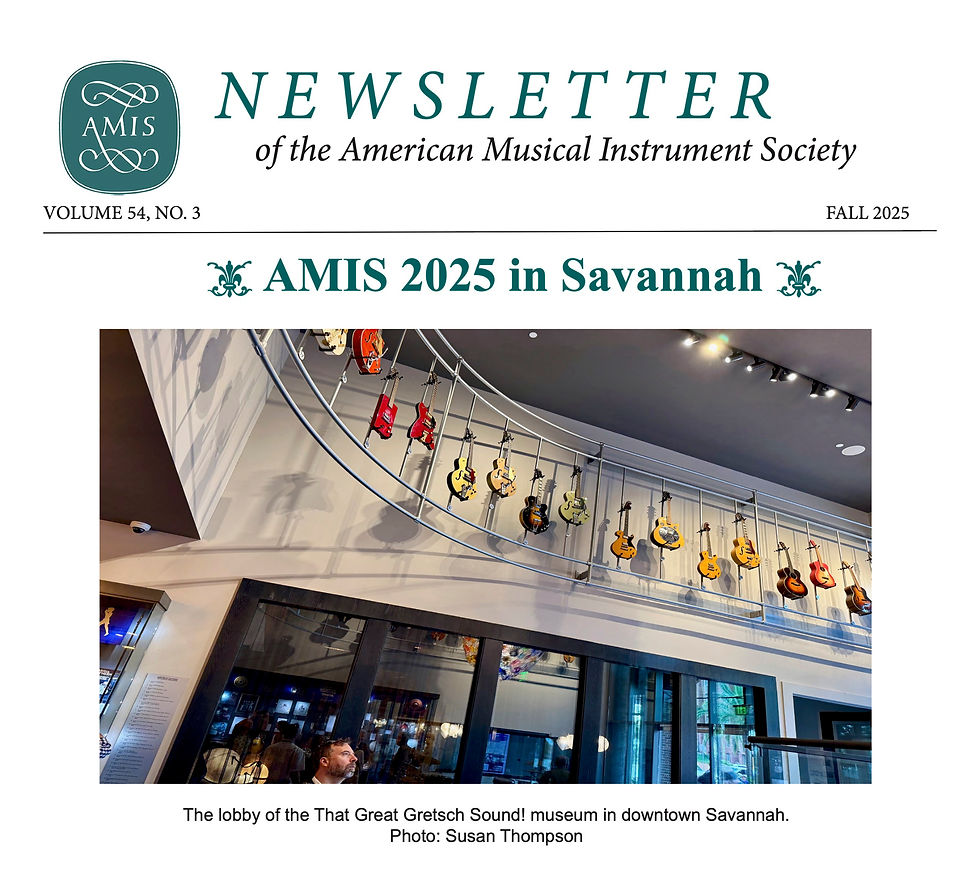Organology: Some Thoughts about an Obscure Term
- AMIS Blogs

- Dec 4, 2018
- 4 min read
Harp (cláirseach), John Kelly, Baltdaniel, Ireland, 1734; Panpipes (paixiao), China, 19th c.; and Soprano Bassoon (fagottino), Johann Christoph Denner, Nuremberg, Germany, about 1700. From the Leslie Lindsey Mason collection at the Museum of Fine Arts, Boston.
By Darcy Kuronen
According to the latest edition of the New Grove Dictionary of Musical Instruments, organology is defined as “The systematic investigation of the history, design, technology, and functions (musical, social, symbolic, etc.) of musical instruments of all times and places.” This seems a very clear and inclusive definition, and well describes the aims of the American Musical Instrument Society and its members. But who the heck came up with the word organology in the first place? And why do we use it (or not)? Those questions have come up regularly for me in my nearly forty years of working with museum collections of musical instruments. So it is that AMIS President Jayson Dobney turned to me as a potentially good candidate to contribute some perspectives about the term “organology,” especially for those who might be new to our Society or to the study of instruments generally. I happily agreed to take on this task inasmuch as a noted scholar who worked with an instrument collection in Boston in the 1930s (and which I currently oversee) seems to be largely responsible for introducing this curious word into our field in the first place.

Although opinions differ somewhat regarding exactly when the word organology first came into existence, it’s a generally held notion that it was popularized (if that’s a truly accurate way to state it) by Nicholas Bessaraboff. This Russian-born engineer and amateur musician utilized the term in a landmark study titled Ancient European Musical Instruments, first published in 1941. The subtitle for this massive tome is An Organological Study of the Musical Instruments in the Leslie Lindsey Mason Collection at the Museum of Fine Arts, Boston. In his introduction, Bessaraboff suggests that there is a “dividing line [that] can be clearly recognized as the difference between music proper and the objective and material means for its expression.” He goes on to say, “Thus the creative, artistic, and scientific aspect of music might be entitled musicology. The scientific and engineering aspect of musical instruments might be entitled organology.”
Thirty years later, music historian and violinist David D. Boyden penned a laudatory essay about Bessaraboff’s magnum opus in Notes (published by the Music Library Association), remarking that his use of the term organology was “audacious.” But Boyden further stated that “Except among specialists, this term is so little understood in general parlance as meaning ‘pertaining to instruments’ that even today [1971] very few dictionaries give this meaning.”
Writing a year earlier than Boyden, in The Galpin Society Journal, Wesley M. Oler provided his own op. ed. about a “Definition of Organology.” He clearly indicts Bessaraboff as the one who “started it,” but then laments that the term is found in scarcely any modern dictionaries, at least not in a sense that defines it as relating to the study of musical instruments (rather than internal medicine). He uses the GSJ itself as a barometer of the word’s acceptance among the very people most likely to employ it, noting that it was employed by only a handful of times in this important journal between the appearance of its first issue in 1948 and 1970. Most tellingly, Oler relates the story of his own election to a “Washington club,” and though he was prepared to describe himself to its admissions committee as an organologist, he feared being called a braggart. He says that they instead called him a pedant, “for having the effrontery to go beyond the dictionaries.”
I can well relate to Oler’s feelings about the term organology, and have had my own concerns about people looking at me quizzically were I to casually drop this word into conversation, assuming that I’m trying to be pretentious. At the many social gatherings and museum events I’ve attended over the years, I dare say that most of the friends and colleagues there (however learned) would scarcely know what a musicologist is, let alone an organologist. I would add, however, that few of them likewise understand what a curator is, though to be fair I suppose that most of them have also never met a curator whose work is devoted specifically to musical instruments.
So, where does that leave us? It seems to me that if the word organology has not caught on much in the nearly 80 years since Bessaraboff introduced it (including among those who are most likely to identify themselves as organologists), then there is little hope of it gaining further acceptance in the next 80 years. I personally tell people that I’m someone who studies musical instruments and their history. It’s more cumbersome than just saying I’m an organologist, but certainly clearer. And that’s fine by me. Titles alone don’t often provide a very good sense of who a person is or what they do. Have you ever stopped and wondered what a sociologist actually does? Or a political scientist? And maybe in a future blog we need to tackle the term “lutherie.” That’s another foreign-sounding word in our field that can make one sound pompous if you’re among the wrong crowd.
Darcy Kuronen is the Papparlardo Curator of Musical Instruments at the Museum of Fine Arts, Boston. He has served on the Board of Governors, on numerous AMIS committees, and as Vice-President from 2005 until 2007. Kuronen's article titled "The Musical Instruments of Benjamin Crehore" published by the Journal of the Museum of Fine Arts (1992) received the Densmore Publication Prize for most distinguished English-language article-length publication.









Comments